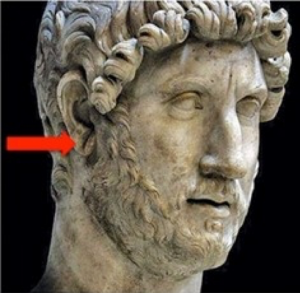Have you ever noticed a diagonal line on someone’s earlobe? Ever wondered what it is? It is called Frank’s Sign after Dr. Sanders T. Frank who observed this crease on 20 patients with angina (1). Studies also call this sign DELC (Diagonal Earlobe Crease) and have found it prevalent in coronary artery disease, peripheral vascular disease and cerebrovascular disease (2,3,4).
Although this sign is more common among patients with coronary issues, the sign is identified well before symptoms occur or tests show coronary issues. A meta-analysis shows a significant trend in association between DELC and cardio events (5).
Theories vary as to why this sign appears on the ear when there is a cardiovascular concerns (6). Some reports indicate micro-vascular deterioration in the earlobe which are end-artery areas. Others include telomere length in patients with metabolic syndrome and atherosclerosis (7). In Auricular therapy, the area is found to have higher electrical conductivity and tenderness when DELC is identified (8).
There is actually a grading system when DELC is identified that corresponds to cardiovascular events depending on length, depth, inclination and bilateralism. If the sign is on only the left ear and does not go across the entire lobe (unilateral incomplete) it is defined as least severe. If the sign is bilateral complete it is considered most severe (5).
Look at your family, friends’ and neighbors’ ears and see if you can find Frank’s Sign on their ears. If you do, share this article and let them know that cardiovascular disease can be identified and corrected before tests or symptoms begin to show up!
References:
1. Frank ST. Aural sign of coronary-artery disease. N Engl J Med [Internet] 1973 [cited 2015 Jun 28];289(6):327–8. Available from: http://www.ncbi.nlm.nih.gov/pubmed/4718047
2. Evrengül H, Dursunoğlu D, Kaftan A, et al. Bilateral diagonal earlobe crease and coronary artery disease: a significant association. Dermatology [Internet] 2004 [cited 2015 Jun 24];209(4):271–5. Available from: http://www.karger.com/Article/FullText/80847
3. Korkmaz L, A X011f Ac MTXK, Acar Z, et al. Earlobe Crease May Provide Predictive Information on Asymptomatic Peripheral Arterial Disease in Patients Clinically Free of Atherosclerotic Vascular Disease. Angiology [Internet] 2014;65(4):303–7. Available from: http://www.ncbi.nlm.nih.gov/pubmed/23449604
4. Çelik Ş, Erdoǧan T, Gedikli Ö, Kiriş A, Erem C. Diagonal ear-lobe crease is associated with carotid intima-media thickness in subjects free of clinical cardiovascular disease. Atherosclerosis 2007;192(2):428–31.
5. Rodríguez-López C, Garlito-Díaz H, Madroñero-Mariscal R, et al. Earlobe Crease Shapes and Cardiovascular Events. Am J Cardiol [Internet] 2015;116(2):286–93. Available from: http://linkinghub.elsevier.com/retrieve/pii/S0002914915011200
6. Shoenfeld Y, Mor R, Weinberger A, Avidor I, Pinkhas J. Diagonal Ear Lobe Crease and Coronary Risk Factors. J Am Geriatr Soc [Internet] 1980 [cited 2015 Jun 29];28(4):184–7. Available from: http://doi.wiley.com/10.1111/j.1532-5415.1980.tb00514.x
7. Higuchi Y, Maeda T, Guan J-Z, Oyama J, Sugano M, Makino N. Diagonal earlobe crease are associated with shorter telomere in male Japanese patients with metabolic syndrome. Circ J 2009;73(2):274–9.
8. Kwai-Ping Suen L, Lau Y, Ma H, Lai K, Holroyd E. Predictive Value of Auricular Diagnosis on Coronary Heart Disease. Evidence-Based Complement Altern Med [Internet] 2012;2012:1–9. Available from: http://www.hindawi.com/journals/ecam/2012/706249/




